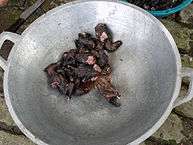Bat as food
Bats are a food source for humans in the Pacific Rim and Asia. Bats are consumed in various amounts in Indonesia, Thailand, Vietnam, Guam, and in other Asian and Pacific Rim countries and cultures.[1][2] In Guam, Mariana fruit bats (Pteropus mariannus) are considered a delicacy,[3][4] and a flying fox bat species was made endangered due to being hunted there.[1] In addition to being hunted as a food source for humans, bats are also hunted for their skins.[1] Hunting techniques include netting and with a shotgun.[1]
The 1999 version of The Oxford Companion to Food states that the flavor of fruit bats is similar to that of chicken, and that they are "clean animals living exclusively on fruit".[1] Bats are prepared in several manners, such as grilled, barbecued, deep fried, cooked in stews and in stir frys.[1] When deep fried, the entire bat may be cooked and consumed.[1] Bats have a low fat content and are high in protein.[1][5]
During cooking, bats may emit strong odors reminiscent of urine. This may be reduced by adding garlic, onion, chili pepper or beer during cooking.[1][5]
Dangers
Eating fruit bats is linked to a neurological disease called lytico-bodig disease. Paul Alan Cox from the Hawaiian National Tropical Botanical Garden in Kalaheo, and Oliver Sacks from Albert Einstein College in New York, found the bats consumed large quantities of cycad seeds, and – like some eagles, which were shown to build up levels of the pesticide DDT in fat tissue – probably accumulate the toxins to dangerous levels.[6]
Dishes

Paniki is an exotic dish of Minahasan from North Sulawesi made from fruit bat.[7][8]
Soups, stews and curries using bat meat are prepared.[1] In Palau, bat soup is considered a delicacy.[9] Fruit bats are used in a Palauan soup that includes coconut milk, spices and ginger.[9]
Stews
Bat stew is a stew prepared from various types of bats.[1][5] Fruit bats are used in some versions of the dish.[5]
Estufa de morcego is a bat stew delicacy in the cuisine of São Tomé and Príncipe that is served on saints days and during fiestas.[10]
- Bat preparation
 Bats for human consumption in Laos
Bats for human consumption in Laos Preparation prior to cooking
Preparation prior to cooking Another image of preparation
Another image of preparation Ready for cooking
Ready for cooking
See also
| Wikimedia Commons has media related to Bats as food. |

References
- 1 2 3 4 5 6 7 8 9 10 11 Extreme Cuisine: The Weird & Wonderful Foods that People Eat – Jerry Hopkins. pp. 51-53.
- ↑ The Genie in the Bottle: 67 All-New Commentaries on the Fascinating ... - Joe Schwarcz. p. 95.
- ↑ Texas Monthly. p. 116.
- ↑ Bats of the United States and Canada. pp. 79-80.
- 1 2 3 4 Downes, Stephen (1 January 2006). "To Die For". Allen & Unwin – via Google Books.
- ↑ "Bat-Eating Linked to Neurological Illness", National Geographic, June 13, 2003
- ↑ Rosliana, Valentina (14 April 2008). "Ke Tomohon, Makan Tikus atau Kelelawar?" (in Indonesian). Indonesia: Kompas. Retrieved 2011-01-09.
- ↑ Febriane, Sarie; Soelastri Soekirno; Pingkan E. Dundu (30 August 2008). "Panas Membara dari Timur Indonesia" (in Indonesian). Indonesia: Kompas. Retrieved 2011-01-09.
- 1 2 Listverse. Com's Ultimate Book of Bizarre Lists – Jamie Frater. p. 207.
- ↑ Sao Tome and Principe – Kathleen Becker. pp. 74-79.